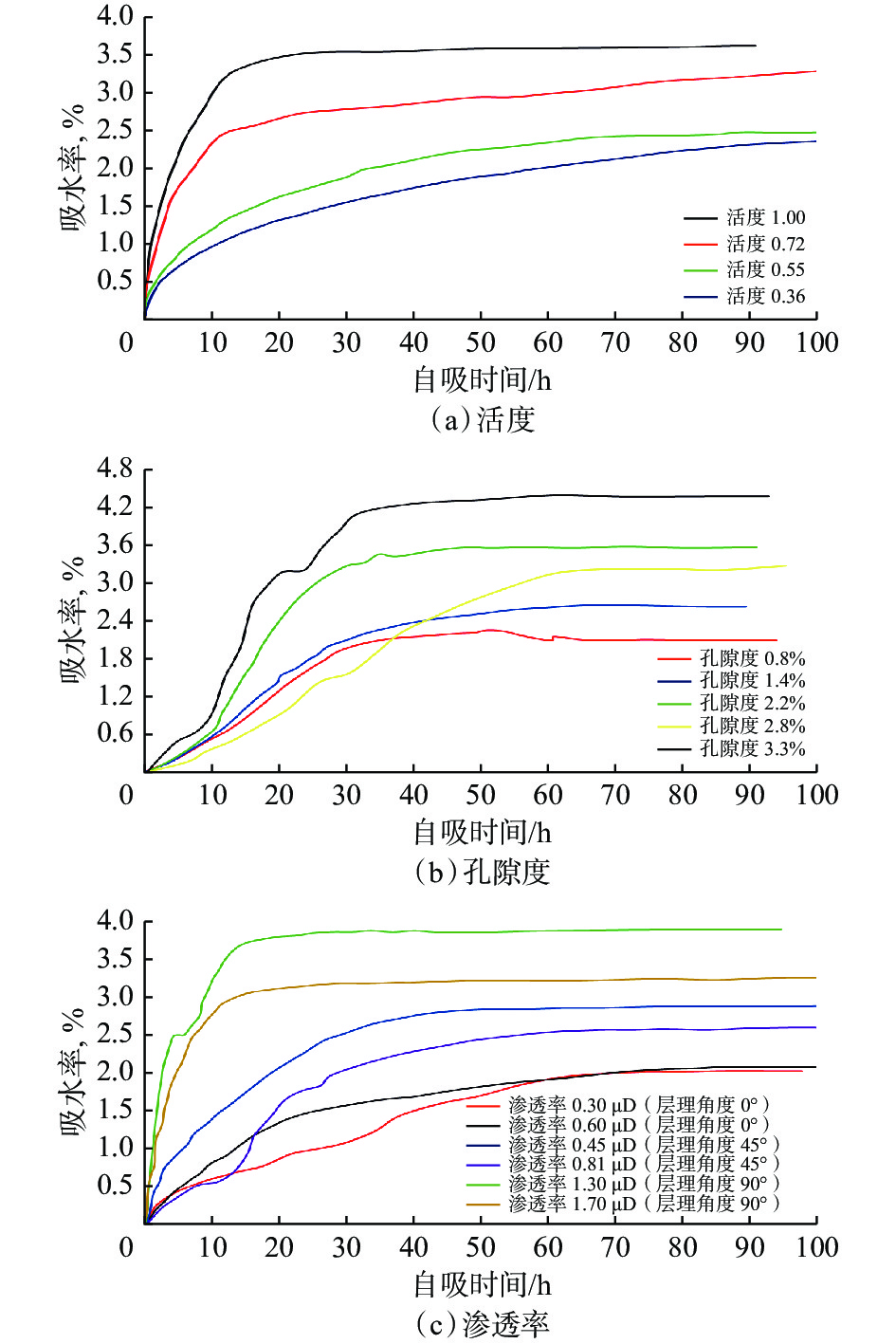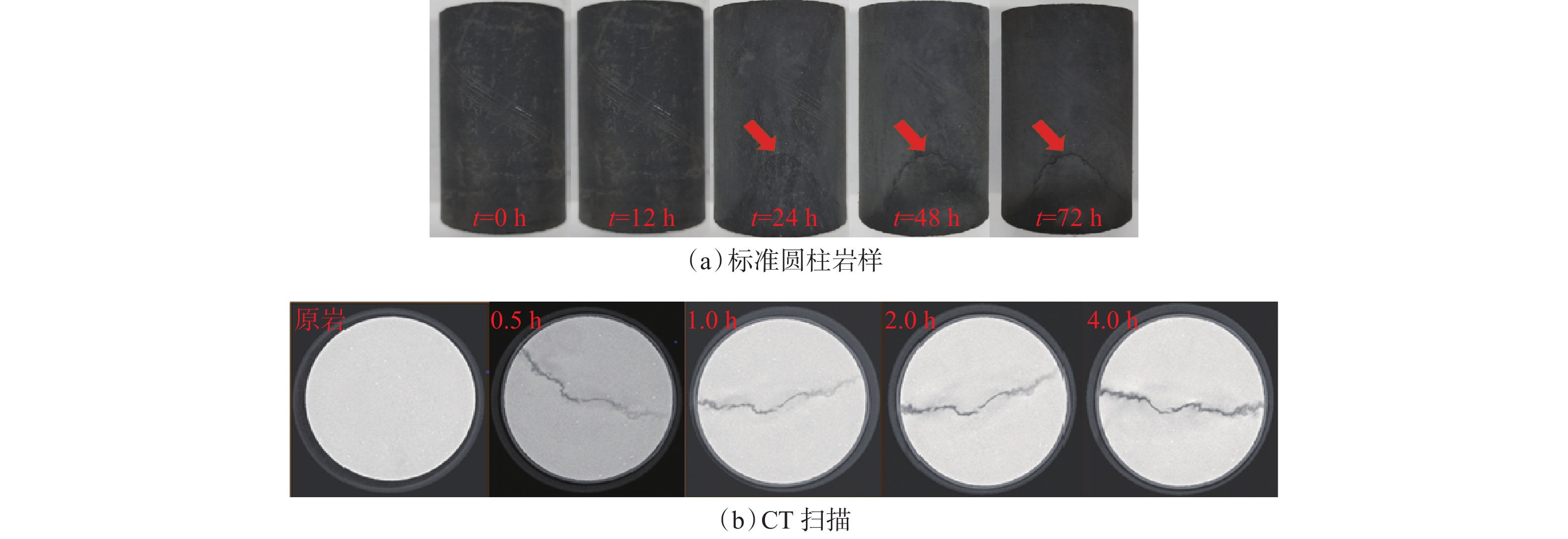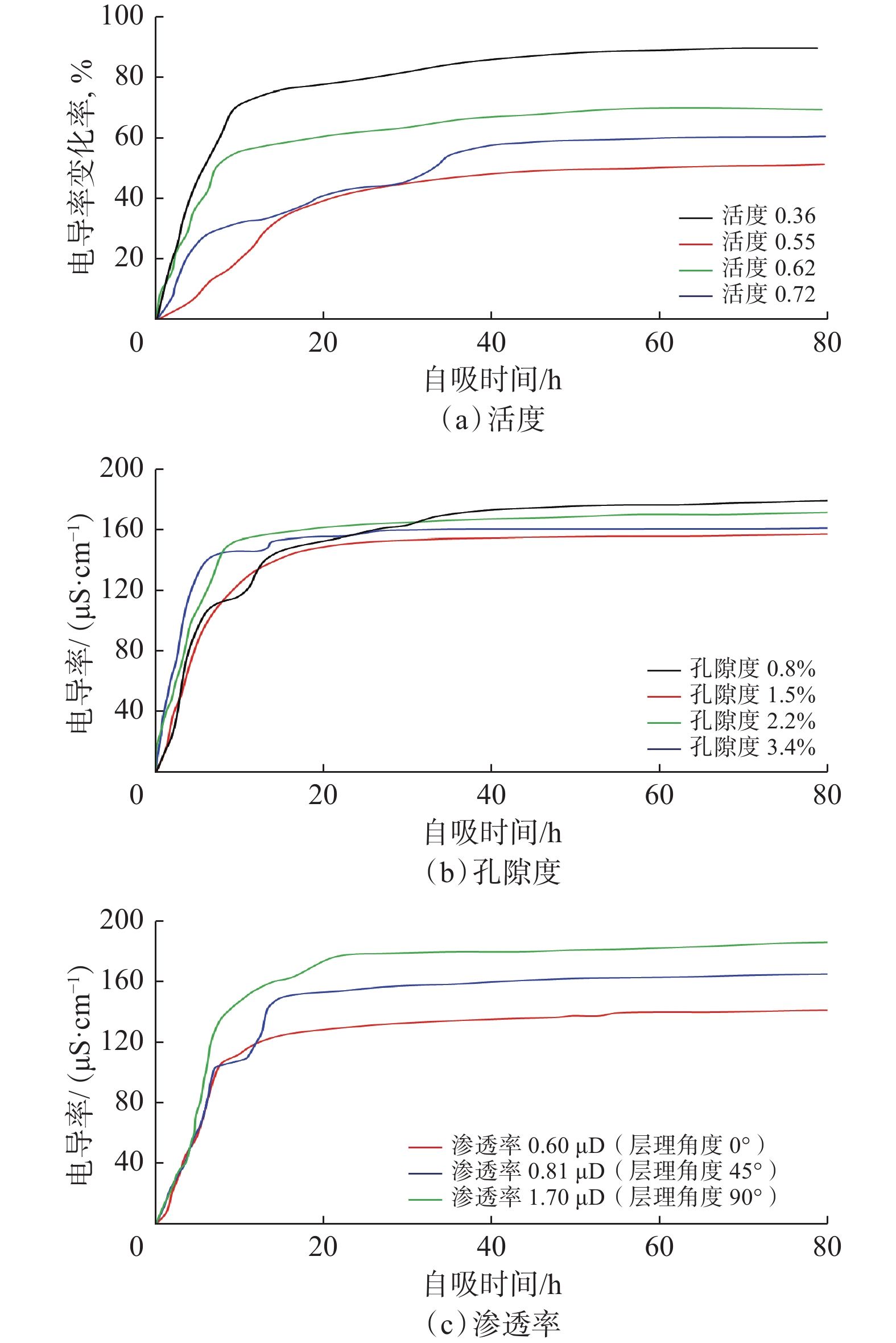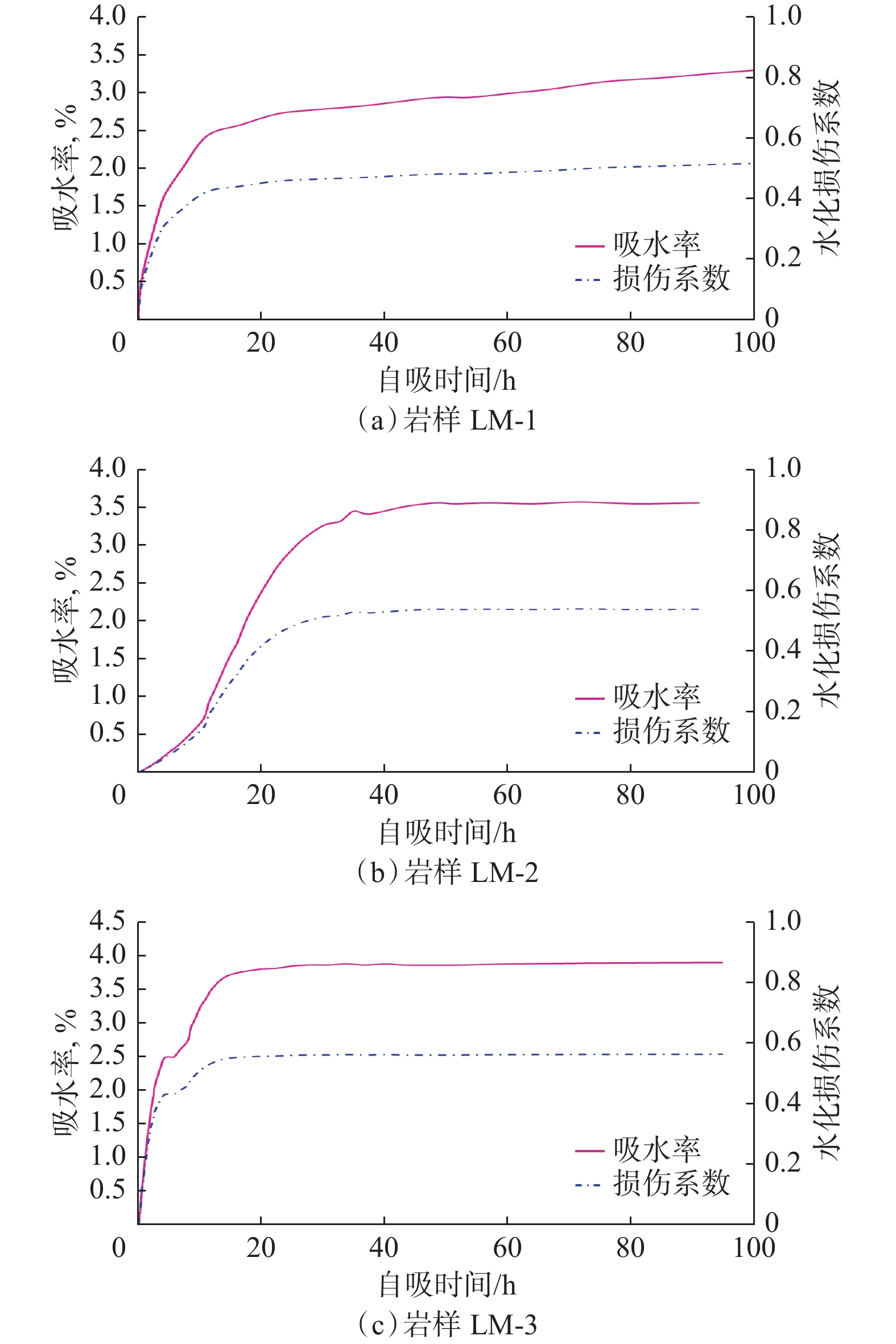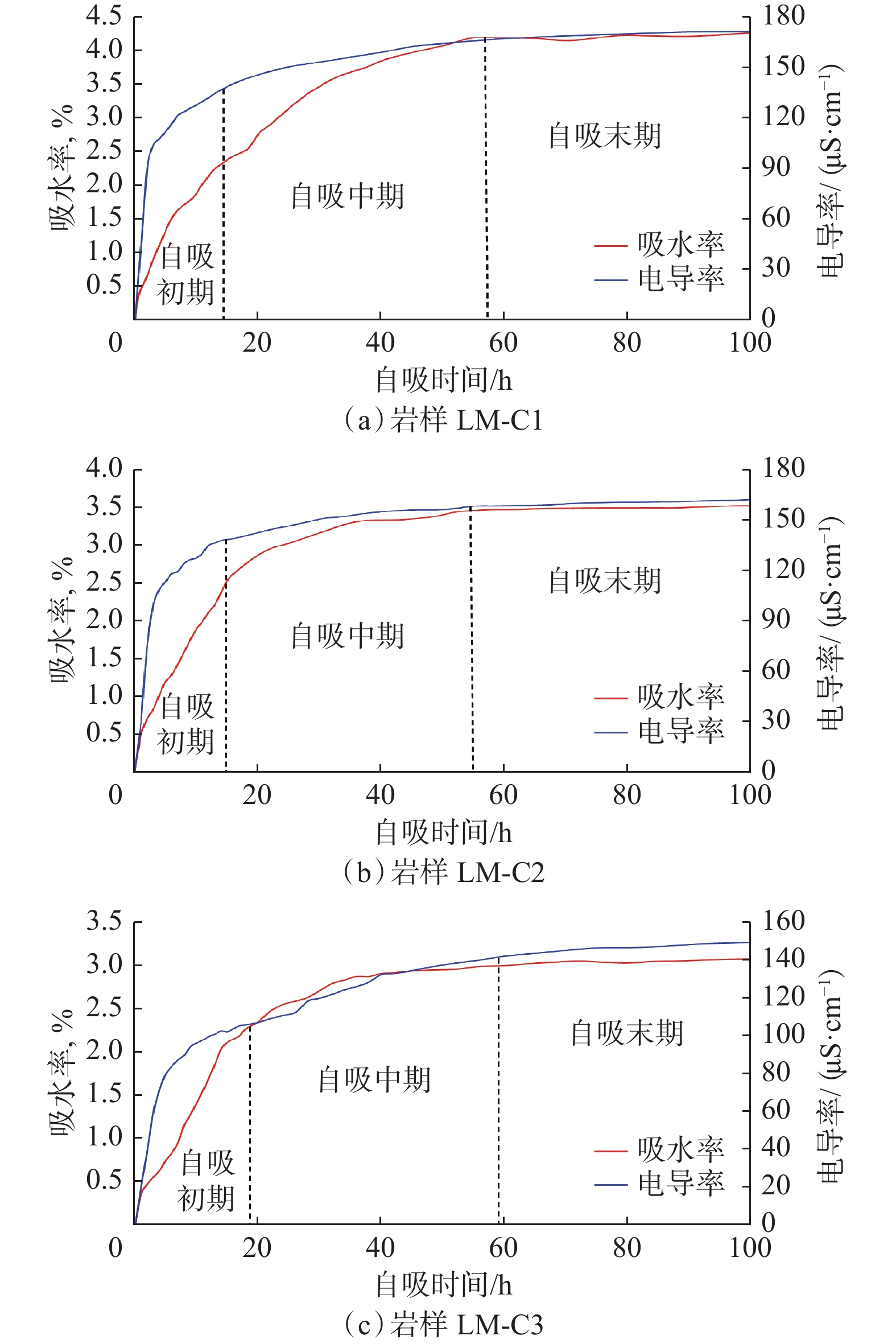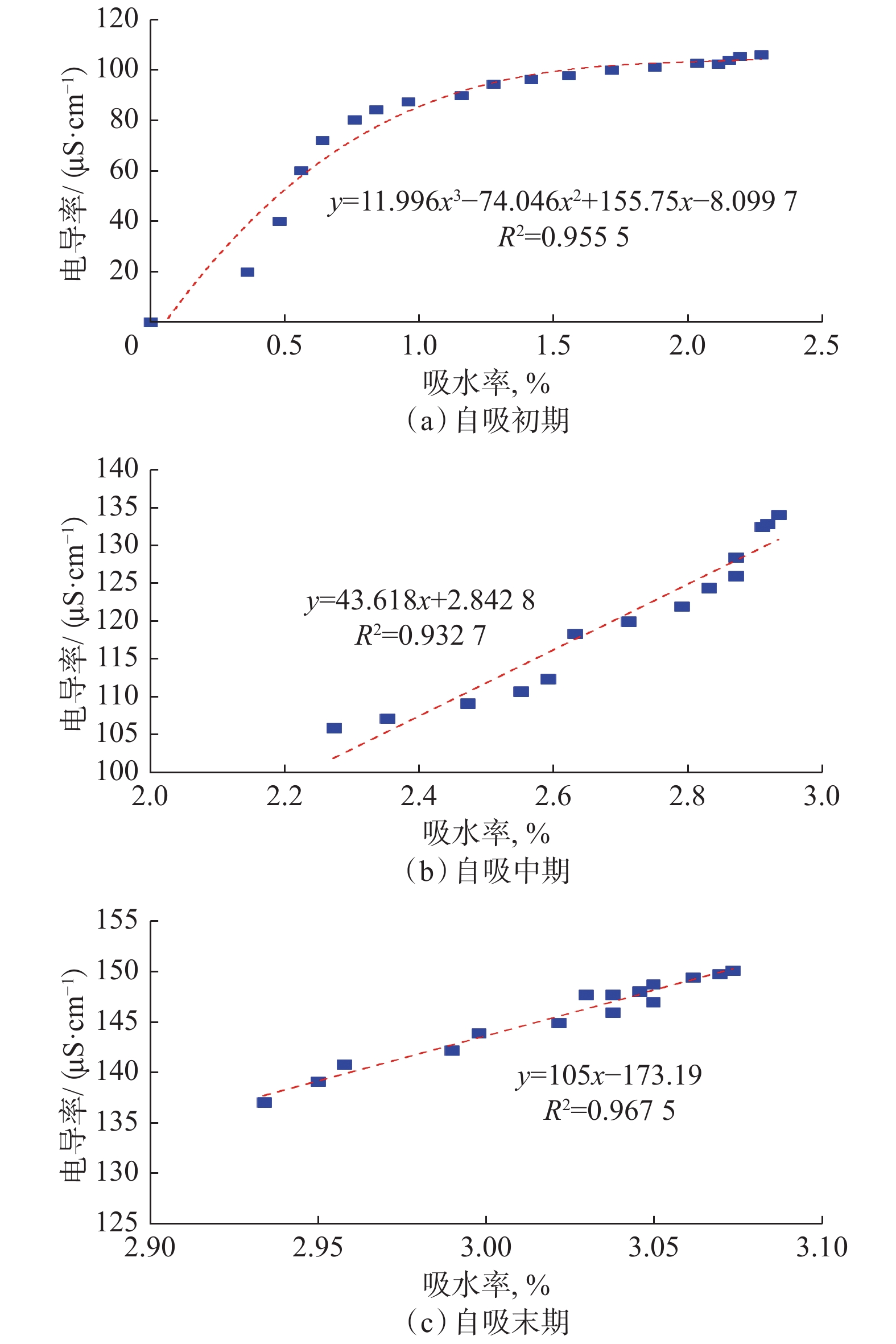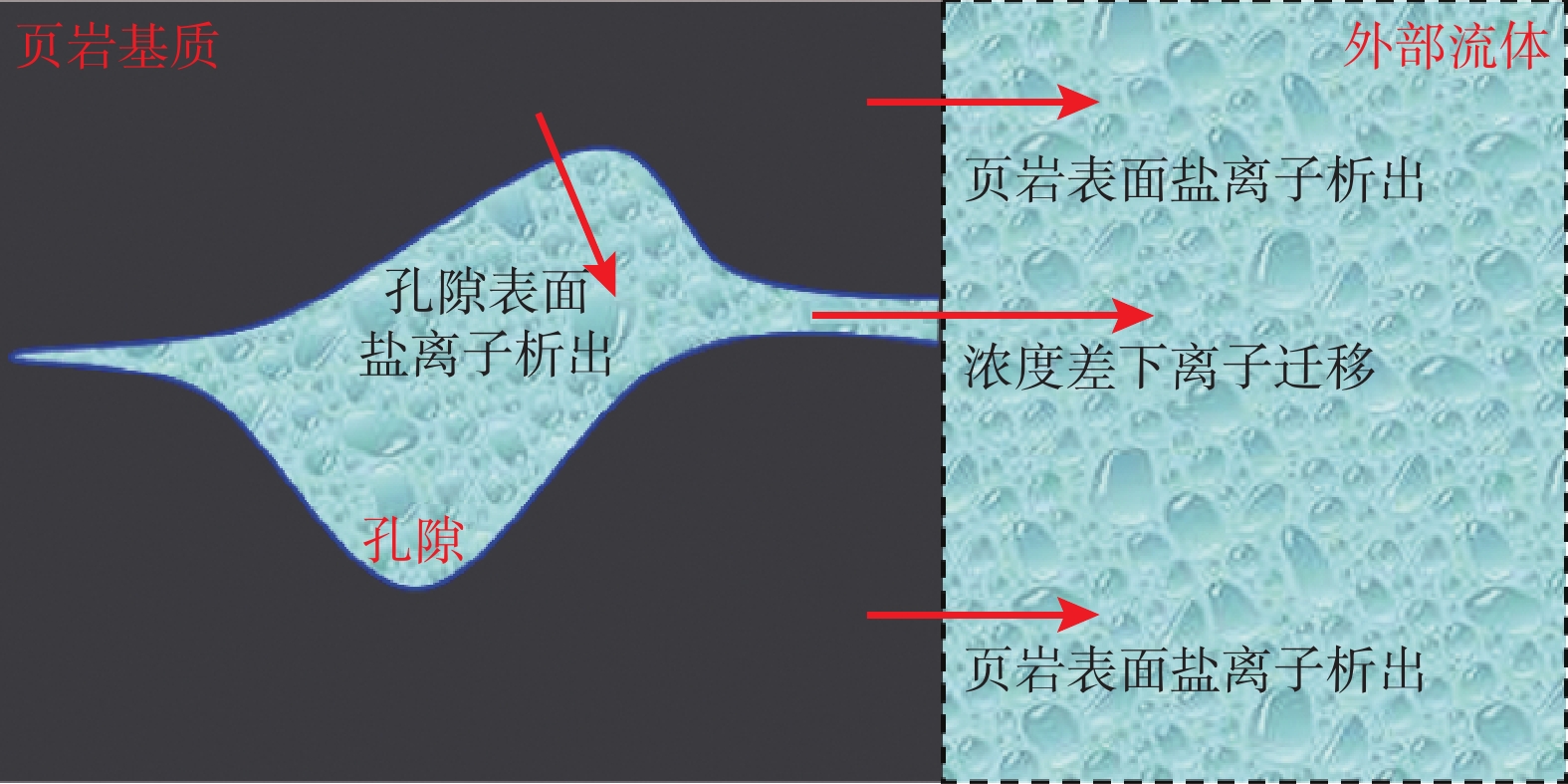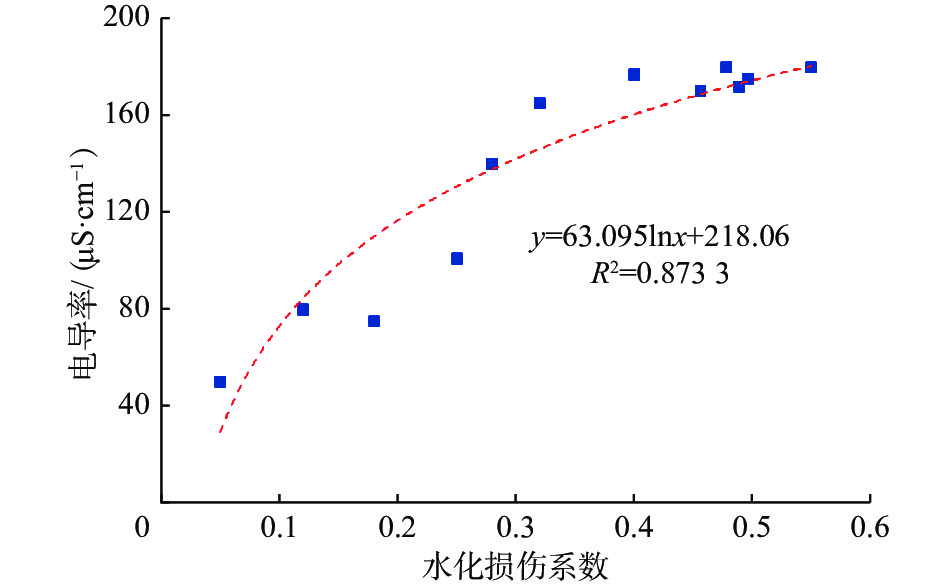Experimental Research on the Correlation of Spontaneous Imbibition–Hydration Damage–Ion Diffusion in Shale Gas Reservoirs
-
摘要:
压裂液与页岩气储层接触后,诱发自吸、水化损伤及离子扩散等水岩反应,导致压裂液返排率低、矿化度高,对压裂改造效果与页岩气产出均有显著影响。目前对上述水岩反应已经开展了针对性研究,但自吸、水化损伤及离子扩散同步产生,对三者之间相关性的研究较缺乏,难以准确认识压裂液与页岩的相互作用,不利于压裂优化设计。为此,立足于室内试验手段,明确了不同条件下的页岩自吸、水化损伤及离子扩散规律及影响因素,系统分析了页岩自吸、水化损伤及离子扩散之间的定量相关性以及相互作用机制。研究结果显示:自吸、水化损伤及离子扩散具有同步响应特征,均在自吸前期发展显著,后续逐渐趋于稳定;自吸与水化损伤相互促进,使页岩吸水量增大;随页岩吸水量增大,离子扩散程度加剧,更多盐离子扩散进入压裂液,使压裂液活度降低,减弱页岩自吸与水化程度。研究成果深化了对压裂液与页岩相互作用的认识,为实现页岩气储层高效水力压裂改造提供了理论支撑。
Abstract:The interaction between shale gas reservoirs and fracturing fluid triggers water–rock reactions, such as spontaneous imbibition, hydration damage, and ion diffusion, restulting in low flowback rate and high salinity, which have a huge impact on fracturing results and shale gas production. Currently, research on these water–rock reactions has been conducted. However, spontaneous imbibition, hydration damage, and ion diffusion simultaneously occur, and the research on relations among these water–rock reactions is not enough. As a result, it is not beneficial for a deep understanding of the interaction between fracturing fluid and shale and the optimization design of fracturing. Therefore, based on laboratory experiments, the law and influence factors of shale spontaneous imbibition, hydration damage, and ion diffusion with various conditions were determined. Investigations of quantitative correlation and interaction mechanisms among shale spontaneous imbibition, hydration damage, and ion diffusion were completed. Results indicated that these reactions had synchronous response features and were all strong in earlier stages and gradually became stable. Spontaneous imbibition and hydration damage exhibited mutual promotion, increasing shale imbibition amount. With the increment in imbibition amount, ion diffusion grew, pushing more saline ions into fracturing fluid and reducing the activity of fracturing fluid. Consequently, shale spontaneous imbibition and hydration degree were restricted. The outcomes deepen the understanding of the interaction between fracturing fluid and shale, providing theoretical support for efficient hydraulic fracturing in shale gas reservoirs.
-
Keywords:
- shale gas /
- fracturing fluid /
- spontaneous imbibition /
- hydration damage /
- ion diffusion
-
页岩气资源潜力巨大,是当前石油行业的热点。作为一种清洁高效能源,页岩气的高效开采对保障我国能源安全、实现“双碳”战略目标具有重要意义。现阶段,我国页岩气开采已经取得了初步成效,但整体开发程度低,尚未实现规模化、低成本、绿色开发[1-6]。页岩气储层具有超低渗、超低孔特征,水力压裂是页岩气有效开发的关键技术。深入认识压裂液与页岩的相互作用机制是开展压裂液优化设计的关键,也是实施高效水力压裂的基础。其中,压裂液与页岩接触,自吸、水化损伤及离子扩散是影响压裂施工及压后产量的重要因素,需要开展针对性研究[7-9]。
页岩气储层压裂改造过程中,返排率低,普遍低于30%[10]。不同于常规砂岩、碳酸盐岩储层,页岩气储层常见低返排率、高产的现象[11]。目前,认为页岩气储层返排率低、产量高的主要原因是页岩的强自吸与水化损伤。V. F. Eveline等人[12-14]研究认为:压裂液中的水大量侵入页岩,一方面水逐渐占据孔隙,促进页岩内部气水置换,有利于页岩气产出;另一方面,水化损伤破坏页岩原有的致密结构,达到增渗提产效果。此外,曾凡辉等人[15]认为水相进入页岩气储层后,在部分位置可能产生水锁效应,抑制页岩气产出。由此可见,自吸与水化损伤对压后产能具有显著影响。大量压裂施工数据显示,对于页岩气储层,随返排时间增长,返排液矿化度升高[16-17]。返排液矿化度对认识储层特征、判断储层敏感性损害具有重要意义。M. E. Blauch等人[18-19]研究表明,压裂液的矿化度与页岩气储层的矿物组成密切相关,且离子扩散作用是返排液矿化度高的主要诱因。刘敦卿[20]通过分析自吸与电导率试验结果,认为储层与压裂液之间的离子交换易导致储层湿度平衡被破坏,促进甲烷解吸,利于储层增产。王飞等人[21]构建了化学势驱动下的压裂液返排数值模型,认为化学势差形成的离子扩散效应对压裂液侵入储层具有明显的影响。
综上所述,对于页岩气储层压裂改造,自吸、水化损伤与离子扩散等压裂液与页岩的相互作用均为影响压后产量的重要因素。围绕上述3类物理化学反应,众多学者已开展了大量研究,系统分析了自吸、水化损伤与离子扩散三者的影响因素,指出了三者之间相互影响的特征[22-26]。然而,目前围绕三者之间定量相关性的研究较为缺乏,进而难以精确认识与评价压裂液与页岩储层相互作用的特征,不利于指导压裂液优化设计。为此,笔者采用室内试验手段,系统分析了页岩自吸、水化损伤与离子扩散的演变规律,明确了自吸–水化损伤–离子扩散之间的同步响应关系与相互影响机制,深化了页岩–压裂液相互作用机理的认识,对我国页岩气的高效开发具有重要意义。
1. 页岩自吸与溶液电导率同步测试试验
1.1 试验样品
以四川长宁龙马溪组上部页岩露头为研究对象进行试验。其孔隙度主要分布在0.7%~4.2%,渗透率主要分布在0.10~1.83 μD,表现为超低孔超低渗特征。岩石矿物组成测试结果显示:龙马溪组页岩露头以黏土与石英为主,平均含量分别为44.6%和31.4%;黏土矿物以伊利石和伊/蒙混层为主,不含蒙脱石。该龙马溪组页岩露头由于高水敏性矿物含量高,表明其具有强水化特征。为分析不同条件下的页岩自吸、离子扩散现象,选取去离子水与不同质量分数的CaCl2盐溶液为外部流体,构建不同活度的流体环境(活度测试采用饱和湿度法,去离子水的活度为1.00),活度与CaCl2质量分数的相关关系式为:
a=−0.017ω(CaCl2)+1.0 (1) 式中:a为活度;ω(CaCl2)为CaCl2的质量分数。
1.2 试验方法
通过岩样自吸与溶液电导率同步测试(测试装置见图1)分析页岩自吸与离子扩散。页岩岩样以端面自吸形式自吸溶液,通过记录不同自吸时间下页岩岩样质量,得到自吸过程中吸水量变化情况(见式(2)),进而获取自吸曲线。由电化学理论可知,溶液电导率与其内部电解质浓度密切相关,是反应盐离子浓度的重要指标。溶液中盐离子浓度高,表明溶液内部电解质浓度高,电导率强。基于此,采用DDS-11A型电导率仪分析离子扩散效应。
w(t)=W(t)−WoWo×100% (2) 式中:w(t)为页岩岩样自吸t时刻的吸水率;W(t)为页岩岩样自吸t时刻的质量,g;Wo为页岩岩样初始的质量,g。
针对页岩水化损伤,从宏观与微观尺度进行评价与分析。基于不同自吸时间下的标准圆柱岩样,首先观测其表面,分析宏观尺度下的水化损伤特征。通过CT扫描,系统分析微观尺度下的水化结构损伤演化特征。在此基础上,采用超声波测试方法,依据水化结构损伤与声信息的响应关系,定量表征水化损伤。
2. 页岩自吸与水化损伤过程分析
2.1 页岩自吸特征
开展不同条件下的页岩岩样自吸试验,分析页岩的自吸特征。图2所示为页岩岩样不同条件下的自吸曲线。由图2可知:在不同条件下,页岩自吸规律具有一致性,吸水率均在前期迅速升高,后期逐渐趋于稳定;随着外部流体活度增加,总吸水率明显增大;在高活度条件下,吸水率上升更为迅速,达到平衡的时间更短,展现更快的自吸速率(见图2(a))。对于含黏土的页岩地层,当外部流体活度较高时,易产生较高的渗透压驱动水进入地层,发生表面水化或渗透水化,促进自吸。整体而言,高孔隙度条件下,代表岩石内部具有更多流动通道与更大的储水空间,因此,吸水速率和总吸水率都有增加趋势(见图2(b))。值得注意的是,在试验时,部分岩样出现反转,例如孔隙度相对较高岩样(2.8%)的吸水量偏低,其主要原因是:在一定孔隙度下,由于孔隙形态、孔隙分布规律不同依然会导致岩石具有不同自吸能力。页岩渗透率受控于层理结构,层理面矿物定向排列,微孔、微裂缝发育更为显著,从而相对页岩基体,层理面为典型的高渗透面[27]。基于不同层理角度页岩(层理角度分别为0°,45°和90°),测试分析渗透率与自吸的相关性(见图2(c))。层理角度越大,即层理面越靠近吸水方向,页岩渗透率越大。因此,在沿层理面方向,外部流体更容易侵入页岩内部,自吸能力最强。
2.2 页岩水化损伤特征
基于不同自吸时间下的标准圆柱页岩岩样,从宏观和微观角度分析自吸过程中的水化损伤。图3为不同自吸时间下的标准圆柱页岩岩样的外观和CT扫描结果。
从图3可以看出:页岩岩样在24 h左右出现明显裂纹,而在自吸后期(72 h和96 h),裂纹没有进一步扩展的趋势;原岩条件下CT扫描位置无裂纹,自吸0.5 h后裂缝开始扩展,表明前期的水化损伤效应较强;同时,裂缝的另外一侧有裂缝阴影,但并未完全开裂;随着自吸时间增长,裂缝逐渐起裂延伸。由此可见,随自吸时间增长,水化结构损伤逐渐加剧。其中,由于CT扫描只是微尺度定点观测,因此裂纹扩展的终止时间更早,但岩样宏观裂纹扩展需要更长时间才能达到稳定。
3. 页岩离子扩散分析
根据页岩自吸与电导率同步测试结果分析不同条件下页岩自吸过程中的离子扩散。测试层理角度0°页岩岩样不同自吸时间下不同活度外部流体的电导率变化率,结果见图4(a)。测试层理角度0°、不同孔隙度页岩岩样不同自吸时间下外部流体的电导率,结果见图4(b)。测试层理角度0°、45°和90°页岩岩样不同自吸时间下外部流体的电导率,结果见图4(c)。不同孔隙度与渗透率条件下的离子扩散分析均直接采用电导率进行评价(统一以去离子水为外部流体,电导率为0 μS/cm)。此外,由于不同活度流体中离子浓度本身存在差异,无法直接用电导率反映流体活度对离子扩散的影响。因此,采用外部流体电导率的变化率来衡量不同活度流体对离子扩散程度的影响。电导率变化率的表达式为:
Δγc(t)=γc(t)−γc(0)γc(0)×100% (3) 式中:
Δγc(t) 为自吸t时刻下外部流体电导率的变化率,%;γc(t) 为自吸t时刻下外部流体的电导率,μS/cm;γc(0) 为外部流体的初始电导率,μS/cm。在高活度下,离子扩散速率更快,电导率变化率更大,离子扩散程度更强(见图4(a))。由于页岩含盐量高,当外部流体活度偏大,造成页岩与流体的浓度差较大,形成更大的化学势能差,驱动更多水侵入页岩内部,解析出更多盐离子,使外部流体的电导率增大。
对于高孔隙度和高渗透率的页岩岩样(图4(b)和图4(c)),电导率增大更为明显,说明离子扩散现象更为剧烈。但在扩散初期,离子扩散与孔渗相关性较差。因为初期离子主要来源于页岩表面离子解析,与自吸量无明显关系。随着自吸时间增长,离子扩散程度与页岩孔渗具有明显对应性。高孔隙度和高渗透率更利于外部流体自吸进入页岩,导致更多的流体与页岩内部可溶性盐接触,使页岩中的盐离子扩散至外部流体的速度加快。
4. 自吸–水化损伤–离子扩散的相关性
4.1 自吸与水化损伤的相关性
水化损伤会造成页岩结构改变,必然影响页岩内部声波传播,导致声响应信息产生变化。因此,对不同水化时间下的页岩岩样进行超声波测试,通过声波频谱的变化计算水化损伤系数[30],分析不同自吸时间下页岩岩样的吸水率与水化损伤,结果如图5所示。
从图5可以看出,随着页岩吸水率逐渐增大,更多水侵入岩体与页岩发生反应,导致水化损伤程度加剧。因此,随着吸水率增大,水化损伤系数逐渐增大,两者相互对应性较好;尤其是损伤加剧阶段,也是吸水率快速增大的阶段。这是因为损伤发育阶段主要是水化裂纹产生阶段;随着裂纹扩展,页岩孔隙度与渗透率增大,为大量水侵入提供了通道,促进了自吸。
Dh=(Ma−Mc)(Fa−Fc)MaFa (4) 式中:Dh为水化损伤系数;Ma和Mc为分别页岩的原状和水化后的主频,kHz;Fa和Fc分别为页岩的原状和水化后的主频点振幅,mV。
4.2 自吸与离子扩散的相关性
基于典型页岩自吸曲线,将自吸分为初期、中期及末期3个阶段,结合自吸试验结果与电导率测试结果,获取页岩自吸过程中外部流体电导率的变化,分析离子扩散程度;综合自吸曲线与电导率曲线,分析不同自吸阶段的吸水率与电导率的相关性(见图6)。
从图6可以看出,随着自吸过程进行,电导率逐渐增大,代表更多的盐离子进入外部流体,尤其是自吸初期,电导率迅速上升;自吸末期,随着自吸量达到极限,电导率增幅逐渐降低,趋于稳定。电导率变化趋势与自吸曲线趋势具有很好的对应性,说明页岩离子扩散与自吸密切相关。
考虑到离子扩散程度与页岩自吸密切相关,分别对自吸初期、中期及末期阶段吸水率与导电率的相关性进行分析,结果如图7所示。
从图7可以看出,在自吸初期、中期及末期,吸水率与电导率都有较好的相关性。但在页岩自吸的不同阶段,吸水率与电导率相关性的方程有所差异,拟合关系如式(5)所示。在自吸初期,相关性方程呈明显的多项式变化关系;而在自吸中期和末期,吸水率与电导率的相关性呈明显的线性相关。
{γc(t)=11.996w(t)3−74.046w(t)2+155.75w(t)−8.099 7初期γc(t)=43.618w(t)+2.842 8中期γc(t)=105w(t)−173.19末期 (5) 自吸吸水率与电导率的相关性出现变化的原因在于融入了外部流体的离子(见图8)。页岩与外部流体接触时,页岩表面离子发生解析,进入外部流体;外部流体进入页岩内部,页岩内部离子解析出来后,伴随离子扩散进入外部流体。自吸开始时,页岩表面可溶性盐与外部流体接触后优先析出,进入外部流体。页岩孔隙内部的可溶性盐,需要等外部流体自吸进入后,再析出并扩散至外部流体。因此,在自吸初期阶段,页岩与外部流体刚接触时,表面离子瞬间解析,电导率迅速上升,后续逐渐减弱,造成电导率–自吸吸水率的相关性出现改变;随着自吸时间增长,外部可溶性盐逐渐减少,同时更多的外部流体进入页岩内部,页岩孔隙内部的可溶性盐逐渐析出;当自吸达到稳定时,离子扩散也达到了稳定,从而在整个中后期过程中离子扩散与自吸吸水率逐渐呈明显的线性相关。
4.3 水化损伤与离子扩散的相关性
基于不同自吸时间下的页岩岩样,分别以声波信息计算水化损伤系数、以电导率测试评价离子扩散程度,获得离子扩散程度与水化损伤系数的相关性,如图9所示。由图9可知:外部流体的电导率越大,离子扩散程度越高,水化损伤系数越大,说明水化损伤与离子扩散具有正向相关性。由于强水化损伤下更多外部流体侵入,增加了流体与页岩的接触面积,促进了离子扩散。但是,在高电导率条件下,水化损伤速率降低,分析认为主要有2方面原因:一方面,高电导率时水化损伤与自吸逐渐进入稳定阶段,损伤速率自然降低;另一方面,高电导率下盐离子浓度较高,而盐离子是典型的黏土水化抑制剂,导致外部流体活性降低,同时改变流体–页岩界面特征,造成接触角增大,从而降低了渗透压、毛细管力等主要自吸驱动力,减弱了页岩自吸与水化作用,导致损伤速率降低。
5. 结 论
1)研究明确了页岩自吸趋势,自吸前期吸水能力较强,后期趋于稳定。在高活度、高孔隙度及高渗透率条件下,由于高活度下的强渗透压与水化作用、高孔高渗下页岩具备有利的流通通道,导致自吸量更大、自吸速率更快。尤其页岩层理属于典型高渗透面,自吸特征受控于层理角度,当自吸沿层面方向时,自吸能力更强。
2)随着自吸量增大,水与页岩内部黏土的接触面扩大,水化损伤效应增强,自吸量与水化损伤系数具有较好的对应性。同时,随着自吸进行,外部流体的电导率逐渐增大。在自吸初期,外部流体的电导率迅速增大;而在自吸后期,随着自吸量达到极限,外部流体电导率的增幅也逐渐降低,并趋于稳定。由此说明,自吸、水化损伤及离子扩散具有同步响应特征。
3)水化损伤与离子扩散具有正向相关性。强水化损伤有利于更多外部流体侵入,促进了页岩内部离子解析扩散。但是,在高电导率条件下,通常水化损伤与自吸作用达到稳定,离子扩散速率降低。同时,高电导率下盐离子浓度较高,发挥了盐离子抑制黏土水化的作用,降低了流体活性,进而减弱了页岩自吸与水化作用,导致损伤速率降低。
-
-
[1] 张东清,万云强,张文平,等. 涪陵页岩气田立体开发优快钻井技术[J]. 石油钻探技术,2023,51(2):16–21. doi: 10.11911/syztjs.2022097 ZHANG Dongqing, WAN Yunqiang, ZHANG Wenping, et al. Optimal and fast drilling technologies for stereoscopic development of the Fuling shale gas field[J]. Petroleum Drilling Techniques, 2023, 51(2): 16–21. doi: 10.11911/syztjs.2022097
[2] 刘鸿渊,蒲萧亦,张烈辉,等. 中国页岩气效益开发:理论逻辑、实践逻辑与展望[J]. 天然气工业,2023,43(4):177–183. LIU Hongyuan, PU Xiaoyi, ZHANG Liehui, et al. Beneficial development of shale gas in China: theoretical logic, practical logic and prospect[J]. Natural Gas Industry, 2023, 43(4): 177–183.
[3] 任千秋,林然,赵金洲,等. 基于初次压裂地质工程条件及改造效果的页岩气井重复压裂选井模型[J]. 石油钻采工艺,2023,45(2):223–228. REN Qianqiu, LIN Ran, ZHAO Jinzhou, et al. Candidate well selection model of shale gas wells for refracturing based on geological and engineering conditions and stimulation performance of primary fracturing[J]. Oil Drilling & Production Technology, 2023, 45(2): 223–228.
[4] 袁建强. 中国石化页岩气超长水平段水平井钻井技术新进展与发展建议[J]. 石油钻探技术,2023,51(4):81–87. YUAN Jianqiang. New progress and development proposals of Sinopec’s drilling technologies for ultra-long horizontal shale gas wells [J]. Petroleum Drilling Techniques, 2023, 51(4): 81–87.
[5] 李鹏飞. 四川盆地页岩气立体开发缝控压裂技术应用[J]. 特种油气藏,2023,30(2):168–174. Li Pengfei. Application of fracture-controlled fracturing technology in tridimensional development of shale gas in Sichuan Basin[J]. Special Oil & Gas Reservoirs, 2023, 30(2): 168–174.
[6] 刘建亮,王亚莉,陆家亮,等. 中国页岩气开发效益现状及发展策略探讨[J]. 断块油气田,2020,27(6):684–688. LIU Jianliang,WANG Yali,LU Jialiang,et al. Discussion on internal rate of return status and development strategy of China shale gas[J]. Fault-Block Oil & Gas Field,, 2020, 27(6): 684–688.
[7] 游利军,程秋洋,康毅力,等. 页岩裂缝网络水相自吸试验[J]. 中国石油大学学报(自然科学版),2018,42(1):82–89. YOU Lijun, CHENG Qiuyang, KANG Yili, et al. Experimental study on spontaneous water imbibition in fracture networks of shale rocks[J]. Journal of China University of Petroleum(Edition of Natural Science), 2018, 42(1): 82–89.
[8] 杨柳,冷润熙,常天全,等. 页岩气储层渗吸与盐离子扩散相关关系[J]. 中国海上油气,2020,32(2):112–119. YANG Liu, LENG Runxi, CHANG Tianquan, et al. Correlation between the imbibition and salt ion diffusion of shale gas reservoirs[J]. China Offshore Oil and Gas, 2020, 32(2): 112–119.
[9] DEHGHANPOUR H, LAN Q, SAEED Y, et al. Spontaneous imbibition of brine and oil in gas shales: Effect of water adsorption and resulting microfractures[J]. Energy & Fuels, 2013, 27(6): 3039–3049.
[10] 张涛,李相方,杨立峰,等. 关井时机对页岩气井返排率和产能的影响[J]. 天然气工业,2017,37(8):48–60. doi: 10.3787/j.issn.1000-0976.2017.08.006 ZHANG Tao, LI Xiangfang, YANG Lifeng, et al. Effects of shut-in timing on flowback rate and productivity of shale gas wells[J]. Natural Gas Industry, 2017, 37(8): 48–60. doi: 10.3787/j.issn.1000-0976.2017.08.006
[11] 蒋廷学,卞晓冰,王海涛,等. 页岩气水平井分段压裂排采规律研究[J]. 石油钻探技术,2013,41(5):21–25. doi: 10.3969/j.issn.1001-0890.2013.05.004 JIANG Tingxue, BIAN Xiaobing, WANG Haitao, et al. Flow back mechanism study of multi-stage fracturing of shale gas horizontal wells[J]. Petroleum Drilling Techniques, 2013, 41(5): 21–25. doi: 10.3969/j.issn.1001-0890.2013.05.004
[12] EVELINE V F, AKKUTLU I Y, MORIDIS G J. Impact of hydraulic fracturing fluid damage on shale gas well production performance[R]. SPE 181677, 2016.
[13] DING Yi, LIU Xiangjun, LIANG Lixi, et al. Experimental and model analysis on shale spontaneous imbibition and its influence factors[J]. Journal of Natural Gas Science and Engineering, 2022, 99: 104462. doi: 10.1016/j.jngse.2022.104462
[14] 康毅力,杨斌,李相臣,等. 页岩水化微观作用力定量表征及工程应用[J]. 石油勘探与开发,2017,44(2):301–308. doi: 10.11698/PED.2017.02.17 KANG Yili, YANG Bin, LI Xiangchen, et al. Quantitative characterization of micro forces in shale hydration and field applications[J]. Petroleum Exploration and Development, 2017, 44(2): 301–308. doi: 10.11698/PED.2017.02.17
[15] 曾凡辉,张蔷,郭建春,等. 页岩水化及水锁解除机制[J]. 石油勘探与开发,2021,48(3):646–653. doi: 10.11698/PED.2021.03.20 ZENG Fanhui, ZHANG Qiang, GUO Jianchun, et al. Mechanisms of shale hydration and water block removal[J]. Petroleum Exploration and Development, 2021, 48(3): 646–653. doi: 10.11698/PED.2021.03.20
[16] OSSELIN F, NIGHTINGALE M, HEARN G, et al. Quantifying the extent of flowback of hydraulic fracturing fluids using chemical and isotopic tracer approaches[J]. Applied Geochemistry, 2018, 93: 20–29. doi: 10.1016/j.apgeochem.2018.03.008
[17] 王良,胡仁德,杨建,等. 长宁区块页岩压后压裂液离子含量变化研究及应用[J]. 钻采工艺,2019,42(5):99–102. doi: 10.3969/J.ISSN.1006-768X.2019.05.29 WANG Liang, HU Rende, YANG Jian, et al. Research on ion content change in fracturing fluid after fracturing at Changning Block[J]. Drilling & Production Technology, 2019, 42(5): 99–102. doi: 10.3969/J.ISSN.1006-768X.2019.05.29
[18] BLAUCH M E, MYERS R R, MOORE T R, et al. Marcellus shale post-frac flowback waters-where is all the salt coming from and what are the implications?[R]. SPE 125740, 2009.
[19] HALUSZCZAK L O, ROSE A W, KUMP L R. Geochemical evaluation of flowback brine from Marcellus gas wells in Pennsylvania, USA[J]. Applied Geochemistry, 2013, 28: 55–61. doi: 10.1016/j.apgeochem.2012.10.002
[20] 刘敦卿. 压裂液微观渗吸与 “闷井” 增产机理研究[D]. 北京: 中国石油大学(北京), 2017. LIU Dunqing. Research on microcosmic laws of fracture fluid imbibition and mechanism of productivity enhancement by “shut-in” in unconventional hydrocarbon reservoir[D]. Beijing: China University of Petroleum(Beijing), 2017.
[21] 王飞,潘子晴. 化学势差驱动下的页岩储集层压裂液返排数值模拟[J]. 石油勘探与开发,2016,43(6):971–977. WANG Fei, PAN Ziqing. Numerical simulation of chemical potential dominated fracturing fluid flowback in hydraulically fractured shale gas reservoirs[J]. Petroleum Exploration and Development, 2016, 43(6): 971–977.
[22] 游利军,谢本彬,杨建,等. 页岩气井压裂液返排对储层裂缝的损害机理[J]. 天然气工业,2018,38(12):61–69. doi: 10.3787/j.issn.1000-0976.2018.12.007 YOU Lijun, XIE Benbin, YANG Jian, et al. Mechanism of fracture damage induced by fracturing fluid flowback in shale gas reservoirs[J]. Natural Gas Industry, 2018, 38(12): 61–69. doi: 10.3787/j.issn.1000-0976.2018.12.007
[23] DING Yi, YU Xiaolong, LIU Xiangjun, et al. Novel analytical model of shale spontaneous imbibition considering the hydration effect[J]. Energy & Fuels, 2021, 35(22): 18518–18532.
[24] 康圆,孙金声,吕开河,等. 一种页岩气疏水强封堵水基钻井液[J]. 钻井液与完井液,2021,38(4):442–448. KANG Yuan, SUN Jinsheng, LYU Kaihe, et al. Research on a water-based drilling fluid for shale gas drainage and strong blocking[J]. Drilling Fluid & Completion Fluid, 2021, 38(4): 442–448.
[25] 李皋,李泽,蒋祖军,等. 页岩–液体作用对套管变形的影响研究[J]. 西南石油大学学报(自然科学版),2021,43(1):103–110. LI Gao, LI Ze, JIANG Zujun, et al. A study on the Efect of shale-liquid reaction on casing deformation[J]. Journal of Southwest Petroleum University(Science & Technology Edition), 2021, 43(1): 103–110.
[26] 邓媛,何世明,邓祥华,等. 力化耦合作用下的层理性页岩气水平井井壁失稳研究[J]. 石油钻探技术,2020,48(1):26–33. DENG Yuan, HE Shiming, DENG Xianghua, et al. Study on wellbore instability of bedded shale gas horizontal wells under chemo-mechanical coupling[J]. Petroleum Drilling Techniques, 2020, 48(1): 26–33.
[27] 张闯,任松,吴斐,等. 循环荷载下含层理页岩渗透特性试验研究[J]. 岩土力学,2022,43(3):649–658. ZHANG Chuang, REN Song, WU Fei, et al. Experimental study on the permeability characteristics of laminated shale under cyclic loading[J]. Rock and Soil Mechanics, 2022, 43(3): 649–658.
[28] 丁乙. 富有机质页岩自吸动态表征及损伤效应[D]. 成都: 西南石油大学, 2020. DING Yi. Dynamic representation of spontaneous imbibition and its damage effect for rick organic shale[D]. Chengdu: Southwest Petroleum University, 2020.
[29] 庄严. 页岩水化诱导裂缝产生的微观机制[D]. 成都: 西南石油大学, 2022. ZHUANG Yan. Micro mechanism of fracture induced by shale hydration[D]. Chengdu: Southwest Petroleum University, 2022.
[30] LIU Xiangjun, DING Yi, RANJITH P G, et al. Hydration index and hydrated constitutive model of clay shale using acoustic frequency spectrum[J]. Energy Science & Engineering, 2019, 7(5): 1748–1766.
-
期刊类型引用(3)
1. 刘拯君,张衍君,廖婉蓉,杨兵,杨柳,周德胜. 页岩储层盐离子扩散规律及其在压裂缝网诊断中的应用. 新疆石油天然气. 2025(01): 41-49 .  百度学术
百度学术
2. 端祥刚,胡志明,常进,石雨昕,吴振凯,许莹莹. 页岩储层无支撑缝网区流动能力影响因素研究与进展. 特种油气藏. 2025(01): 22-31 .  百度学术
百度学术
3. 雷刚,任建飞,刘佰衢,熊健,刘向君,程万,梁利喜,黎子阳. 超临界CO_2—水—岩相互作用下龙马溪组页岩物理特性演化及其对井壁稳定性影响. 天然气工业. 2025(05): 136-149 .  百度学术
百度学术
其他类型引用(0)




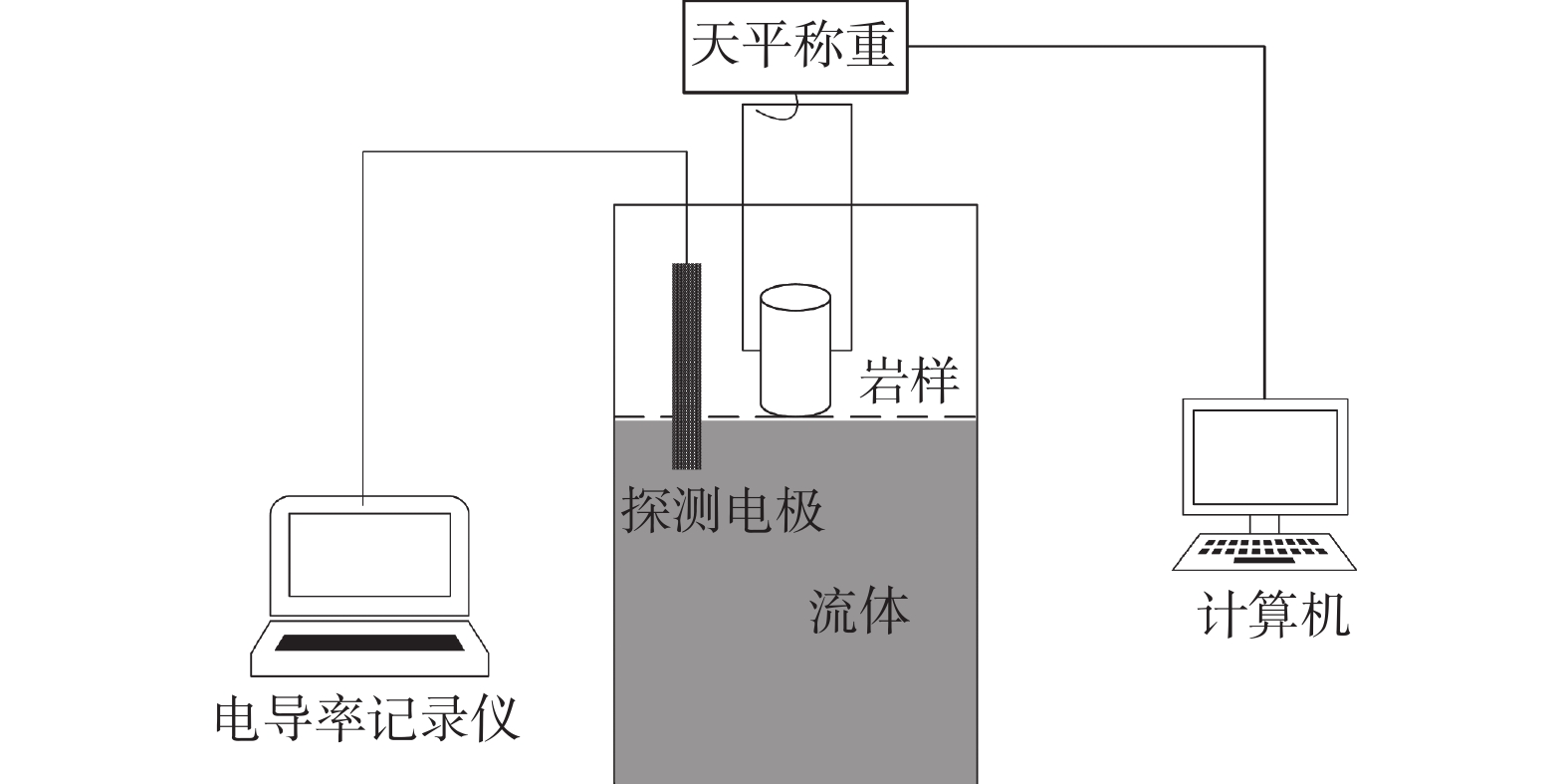
 下载:
下载:

